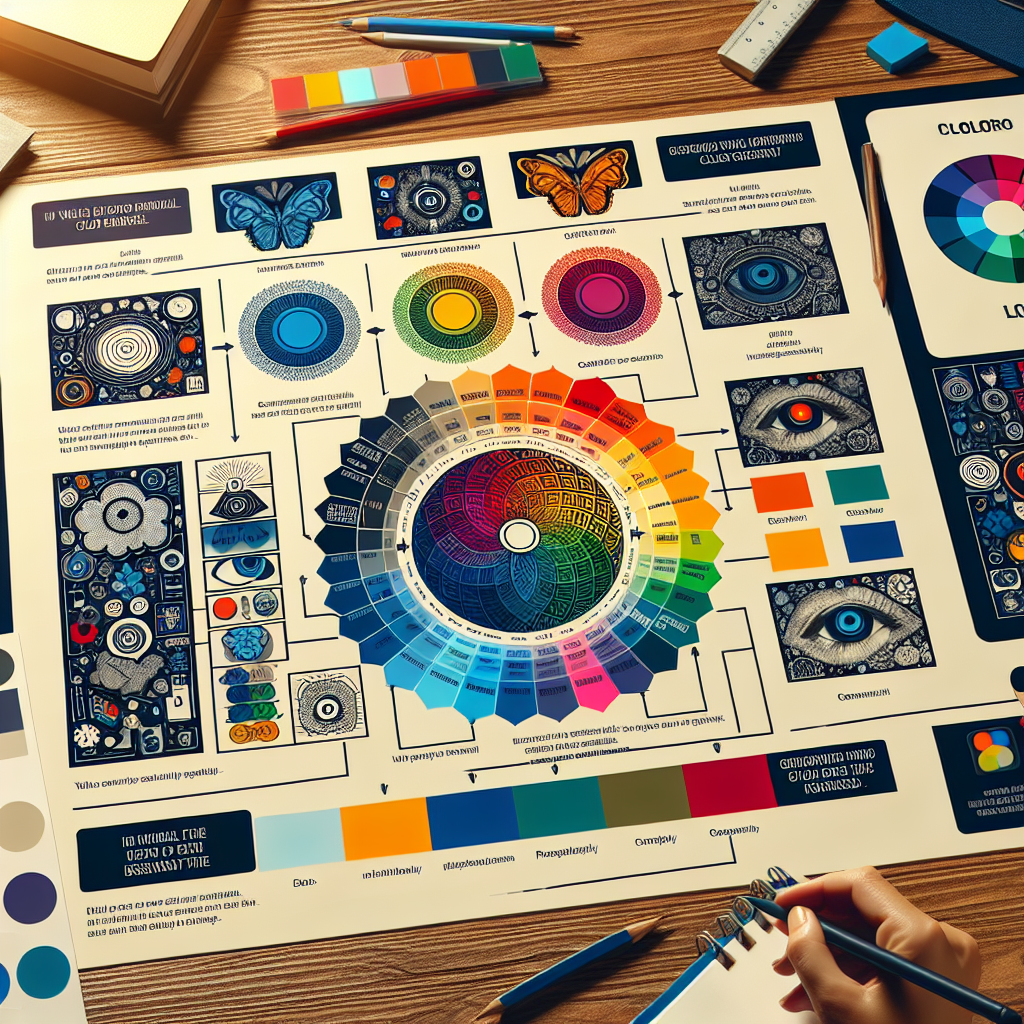Understanding the Psychology of Colors: How to Choose the Right Color Palette for Your Logo
Choosing the right color palette for your logo is a crucial step in creating a powerful and impactful brand identity. Colors have the ability to evoke emotions, convey messages, and leave a lasting impression on your audience. Therefore, it is important to understand the psychology of colors and how to use them effectively in your logo design.
The first step in choosing a color palette for your logo is to understand the meaning and symbolism behind each color. Red, for example, is often associated with passion, energy, and excitement. It can also convey a sense of urgency or danger. On the other hand, blue is often associated with trust, stability, and professionalism. It can also evoke feelings of calmness and serenity.
Once you have a basic understanding of color psychology, it is important to consider your brand’s values and message. What do you want your logo to communicate to your audience? Is your brand playful and fun, or serious and professional? This will help guide your color choices and ensure that your logo accurately reflects your brand’s identity.
Another important factor to consider is your target audience. Different colors can have different meanings and associations in different cultures and demographics. For example, while white may symbolize purity and cleanliness in Western cultures, it can represent mourning in some Eastern cultures. It is important to research and understand the cultural connotations of colors before finalizing your color palette.
In addition to understanding the meaning and symbolism of colors, it is also important to consider the visual impact of your color choices. A good color palette should be visually appealing and harmonious. This means choosing colors that complement each other and create a balanced and cohesive look. A common technique used in logo design is the 60-30-10 rule, where 60% of the logo is made up of the dominant color, 30% of a secondary color, and 10% of an accent color.
Another important aspect to consider is the contrast between colors. A high contrast color palette can create a bold and eye-catching logo, while a low contrast palette can create a more subtle and sophisticated look. It is important to strike a balance between contrast and harmony to create a visually appealing logo.
When choosing a color palette, it is also important to keep in mind the practicality of your logo. Your logo will be used in various mediums such as print, digital, and merchandise. Therefore, it is important to choose colors that will reproduce well in different formats and sizes. Bright and vibrant colors may look great on a computer screen, but they may not translate well in print. It is important to test your color choices in different formats before finalizing your color palette.
Lastly, it is important to remember that your color palette is not set in stone. As your brand evolves and grows, you may need to make changes to your logo and color palette. It is important to regularly review and reassess your color choices to ensure that they still accurately represent your brand and resonate with your audience.
In conclusion, choosing the right color palette for your logo is a crucial step in creating a strong and impactful brand identity. By understanding the psychology of colors, considering your brand’s values and message, and keeping practicality in mind, you can create a visually appealing and effective logo that accurately represents your brand. Remember to regularly review and reassess your color choices to ensure that they continue to reflect your brand’s identity.
The Importance of Contrast and Balance in Color Selection for a Striking Logo Design

Choosing the right color palette for a logo is a crucial step in creating a striking and impactful design. Colors have the power to evoke emotions, convey messages, and leave a lasting impression on viewers. Therefore, it is essential to carefully consider the colors used in a logo to ensure it effectively represents the brand and its values.
One of the key elements to keep in mind when selecting colors for a logo is contrast. Contrast refers to the difference in brightness, hue, or saturation between two colors. It is what makes certain elements stand out and catch the eye. A logo with high contrast colors will be more visually appealing and memorable than one with low contrast colors.
When choosing colors for a logo, it is important to consider the brand’s identity and the message it wants to convey. For example, a brand that wants to portray a bold and energetic image may opt for high contrast colors such as red and black. On the other hand, a brand that wants to convey a more calming and peaceful message may choose low contrast colors like pastel shades.
Another crucial aspect to consider when selecting colors for a logo is balance. Balance refers to the distribution of colors in a design. A well-balanced logo will have an equal distribution of colors, creating a harmonious and visually appealing composition. On the other hand, an unbalanced logo can appear chaotic and unprofessional.
To achieve balance in a logo, it is important to understand the color wheel and its different color schemes. The color wheel is a tool that helps designers understand the relationships between colors. It consists of primary, secondary, and tertiary colors, and their various combinations. By using color schemes such as complementary, analogous, or triadic, designers can create a balanced and visually appealing logo.
Complementary colors are opposite each other on the color wheel, such as red and green or blue and orange. These colors create a high contrast and can be used to make certain elements stand out in a logo. Analogous colors, on the other hand, are next to each other on the color wheel, such as blue, green, and yellow. These colors create a more harmonious and subtle effect, making them suitable for brands that want to convey a sense of unity and balance.
Triadic colors are evenly spaced on the color wheel, creating a balanced and dynamic effect. This color scheme is often used in logos to create a sense of energy and playfulness. However, it is important to use triadic colors carefully as too many bright colors can be overwhelming and take away from the overall impact of the logo.
In addition to contrast and balance, it is also important to consider the psychology of colors when selecting a color palette for a logo. Different colors can evoke different emotions and associations in viewers. For example, red is often associated with passion and energy, while blue is associated with trust and reliability. By understanding the psychology of colors, designers can choose colors that align with the brand’s message and values.
In conclusion, choosing the right color palette for a logo is a crucial step in creating a striking and impactful design. By considering elements such as contrast, balance, and the psychology of colors, designers can create a logo that effectively represents the brand and leaves a lasting impression on viewers. It is important to carefully consider each color used in a logo and how it contributes to the overall message and identity of the brand. With the right color palette, a logo can become a powerful tool in building brand recognition and establishing a strong visual identity.
Tips and Tricks for Creating a Timeless and Memorable Color Palette for Your Brand Identity
Choosing the right color palette for your logo is crucial in creating a strong and memorable brand identity. Colors have the power to evoke emotions, convey messages, and leave a lasting impression on your audience. Therefore, it is essential to carefully select the colors that will represent your brand and its values.
The first step in choosing a color palette for your logo is to understand the psychology behind colors. Each color has its own meaning and can evoke different emotions in people. For example, red is associated with passion, energy, and excitement, while blue represents trust, stability, and professionalism. It is important to consider the message you want to convey and the emotions you want to evoke when choosing your colors.
Another important factor to consider is your target audience. Different colors can have different meanings and associations in different cultures and demographics. For instance, while white is associated with purity and cleanliness in Western cultures, it can represent mourning and death in some Eastern cultures. Therefore, it is crucial to research and understand the cultural significance of colors in your target market to avoid any misinterpretations or misunderstandings.
When selecting a color palette, it is also important to consider the industry and niche your brand belongs to. Different industries have their own color trends and associations. For example, the healthcare industry often uses blue and green to represent trust and health, while the food industry often uses red and yellow to stimulate appetite and excitement. It is important to research the color trends in your industry and choose colors that will make your brand stand out while still fitting in with the industry’s norms.
One of the most effective ways to choose a color palette for your logo is to start with your brand’s values and personality. Your logo should reflect your brand’s identity and values, and the colors you choose should align with them. For instance, if your brand is all about innovation and creativity, you may want to consider using bold and vibrant colors. On the other hand, if your brand is more traditional and professional, you may opt for more muted and neutral tones.
Another helpful tip is to limit your color palette to a maximum of three to four colors. Too many colors can make your logo look cluttered and confusing. It is best to stick to a few colors that complement each other and create a cohesive and harmonious look. You can also use different shades and tones of the same color to add depth and dimension to your logo.
It is also important to consider the practicality of your color palette. Your logo will be used in various mediums, such as print, digital, and merchandise. Therefore, it is crucial to choose colors that will look good and be easily recognizable in different formats. It is also important to consider the accessibility of your colors, especially for people with color blindness. Using high contrast colors can ensure that your logo is easily visible and accessible to everyone.
Lastly, it is essential to test your color palette before finalizing it. Create mock-ups of your logo in different sizes and formats to see how it looks and feels. You can also gather feedback from your target audience and make any necessary adjustments. Remember, your logo and color palette will represent your brand for years to come, so it is important to take the time and effort to choose the right colors.
In conclusion, choosing a color palette for your logo is a crucial step in creating a strong and memorable brand identity. By understanding the psychology behind colors, considering your target audience, industry, and brand values, limiting your palette to a few complementary colors, and testing your logo, you can create a timeless and impactful color palette that will make your brand stand out. Remember, a well-chosen color palette can make all the difference in creating a powerful and recognizable brand.



0 commentaires